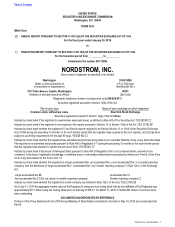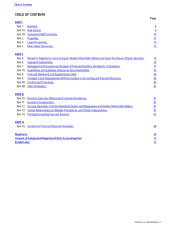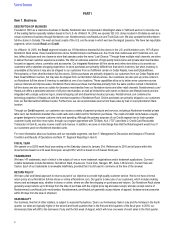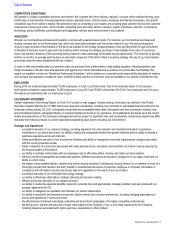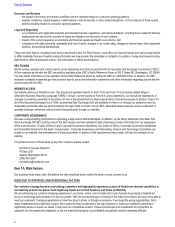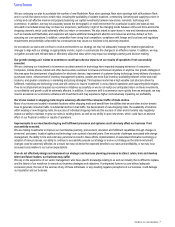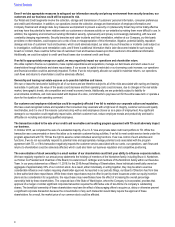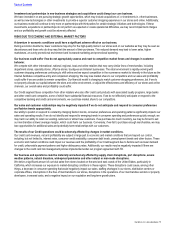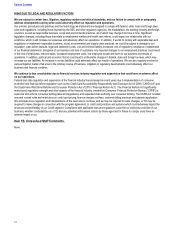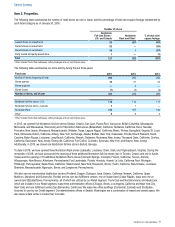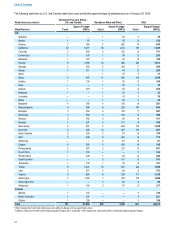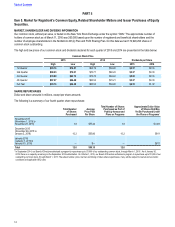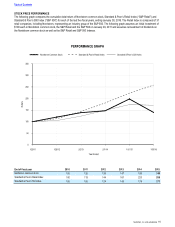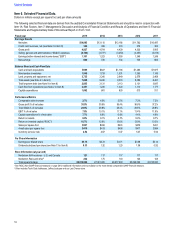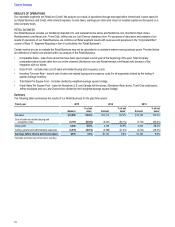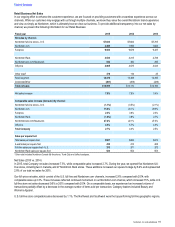Nordstrom 2015 Annual Report Download - page 9
Download and view the complete annual report
Please find page 9 of the 2015 Nordstrom annual report below. You can navigate through the pages in the report by either clicking on the pages listed below, or by using the keyword search tool below to find specific information within the annual report.
Investment and partnerships in new business strategies and acquisitions could disrupt our core business.
We have invested in or are pursuing strategic growth opportunities, which may include acquisitions of, or investments in, other businesses,
as well as new technologies or other investments to provide a superior customer shopping experience in our stores and online. Additionally,
our business model will continue to rely more on partnerships with third parties for certain strategic initiatives and technologies. If these
investments, acquisitions or partnerships do not perform as expected or create operational difficulties, we may record impairment charges
and our profitability and growth could be adversely affected.
RISKS DUE TO ECONOMIC AND EXTERNAL MARKET FACTORS
A downturn in economic conditions could have a significant adverse effect on our business.
During economic downturns, fewer customers may shop for the high-quality items in our stores and on our websites as they may be seen as
discretionary and those who do shop may limit the amount of their purchases. This reduced demand may lead to lower sales, higher
markdowns, an overly promotional environment and increased marketing and promotional spending.
Our business could suffer if we do not appropriately assess and react to competitive market forces and changes in customer
behavior.
We compete with other international, national, regional, local and online retailers that may carry similar lines of merchandise, including
department stores, specialty stores, off-price stores, boutiques and Internet businesses. The retail environment is rapidly evolving with
customer shopping preferences continuing to shift online and we expect competition in the ecommerce market to intensify in the future as the
Internet facilitates competitive entry and comparison shopping. We may lose market share to our competitors and our sales and profitability
could suffer if we are unable to remain competitive. Our financial model is changing to match customer shopping preferences, but if we do
not properly allocate our capital between the store and online environment, or adjust the effectiveness and efficiency of our stores and online
channels, our overall sales and profitability could suffer.
Our Credit segment faces competition from other retailers who also offer credit card products with associated loyalty programs, large banks
and other credit card companies, some of which have substantial financial resources. If we do not effectively anticipate or respond to the
competitive banking and credit card environments, we could lose market share to our competitors.
Our sales and customer relationships may be negatively impacted if we do not anticipate and respond to consumer preferences
and fashion trends appropriately.
Our ability to predict or respond to constantly changing fashion trends, consumer preferences and spending patterns significantly impacts our
sales and operating results. If we do not identify and respond to emerging trends in consumer spending and preferences quickly enough, we
may harm our ability to retain our existing customers or attract new customers. If we purchase too much inventory, we may be forced to sell
our merchandise at lower average margins, which could harm our business. Conversely, if we fail to purchase enough merchandise, we may
lose opportunities for additional sales and potentially harm relationships with our customers.
The results of our Credit operations could be adversely affected by changes in market conditions.
Our credit card revenues, net and profitability are subject in large part to economic and market conditions that are beyond our control,
including, but not limited to, interest rates, consumer credit availability, consumer debt levels, unemployment trends and other factors. These
economic and market conditions could impair our revenues and the profitability of our Credit segment due to factors such as lower demand
for credit, unfavorable payment patterns and higher delinquency rates. Additionally, our results may be negatively impacted if there are
changes to the credit card risk management policies implemented under our program agreement with TD.
Our business and operations could be materially and adversely affected by supply chain disruptions, port disruptions, severe
weather patterns, natural disasters, widespread pandemics and other natural or man-made disruptions.
We derive a significant amount of our total sales from stores located on the west and east coasts of the United States, particularly in
California, which increases our exposure to market-disrupting conditions in these regions. These disruptions could cause, among other
things, a decrease in consumer spending that would negatively impact our sales, staffing shortages in our stores, distribution centers or
corporate offices, interruptions in the flow of merchandise to our stores, disruptions in the operations of our merchandise vendors or property
developers, increased costs, and a negative impact on our reputation and long-term growth plans.
Table of Contents
Nordstrom, Inc. and subsidiaries 9

